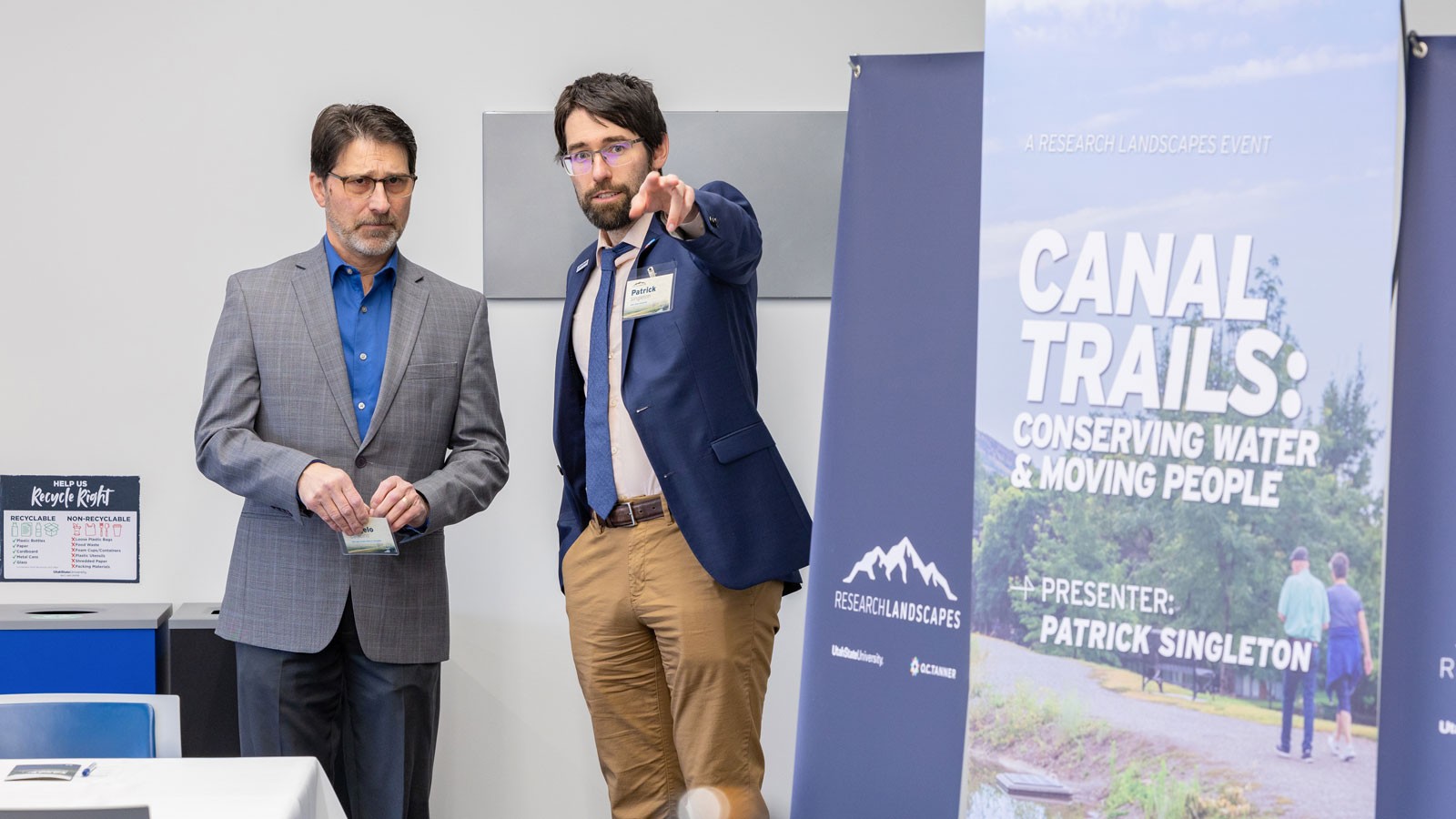Active Transportation Options in Utah the Focus at Latest Research Landscapes
By Kirsten Reither |
Patrick Singleton, right, speaks with Angelo Calacino, a park development project manager with Salt Lake County, at a Research Landscapes event at USU's Salt Lake Center on Feb. 8, 2024.
Using canals as a method to transport water has a long history in Utah. Communities throughout Utah are interconnected by canals, and the water that moves through them has helped the state flourish. Now, new ideas are showing how canals can provide even more benefits.
At the latest Research Landscapes event, Patrick Singleton discussed his research on canal trails and the active transportation options they provide. The presentation, titled “Canal Trails: Conserving Water and Moving People,” was hosted at Utah State University’s Salt Lake Center on Thursday, Feb. 8.
Active transportation involves moving people between destinations through physical exercise, and typically relies on trails and other transportation corridors to entice users.
“Walking and bicycling are healthy forms of physical activity and they have many benefits for physical and mental health,” said Singleton, head of Utah State University’s Singleton Transportation Lab, during his presentation. “We’ve seen an increase in the demand for outdoor recreation, especially during and since the COVID-19 pandemic.”
In his presentation, Singleton emphasized the role of canal trails as an option to provide accessible active transportation. These corridors, as the name implies, involve building a path next or on top of an existing canal.
“Importantly, it’s multiple uses for the same land,” Singleton said.
There are two primary factors that make canals options for active transportation trails. First, they provide a pathway that is relatively flat with little elevation change. And second, they are also generally located in urban and suburban areas and already serve as connectors for communities.
Even when canals aren’t designed with a trail for pedestrian traffic, they often see a significant number of people using them as trails, sometimes illegally. This creates a safety risk for the pedestrians and liability risk for the canal owners.
Because of this, there has been a push for more canals to formally add trails. The Utah State Legislature allocated $45 million in annual funding to the Utah Department of Transportation for the purpose of creating paved trails, some of which is being used to sponsor canal trails.
Safety concerns about increasing activity alongside active waterways can be addressed by burying the canals. These enclosed canals greatly reduce the risk for trail users, and seem to provide a significant increase in water savings while reducing maintenance costs for canal owners.
“All of the canal operators we interviewed said they would be open to enclosing their canal if the funding were available,” Singleton said. “They recognize the benefits to water savings, reduced maintenance, and improved management of the water flow.”
The event also included a live panel question-and-answer session, which featured:
- Patrick Singleton, Utah State University.
- Matthew Crump, J-U-B Engineers.
- Stephanie Tomlin, Utah Department of Transportation.
- Angelo Calacino, Salt Lake County Parks and Recreation.
- Bart Andersen, Utah & Salt Lake Canal Company.
Those interested can view the full presentation and Q&A session on the Office of Research YouTube page.
Research Landscapes is an event series hosted by the Utah State University Office of Research and sponsored by O.C. Tanner. The series connects decisionmakers across the Wasatch Front with the researchers exploring Utah’s land, water and air.
Learn more about past events and RSVP for future events at researchlandscapes.usu.edu.
WRITER
Kirsten Reither
Research Communications
kirsten.reither@usu.edu
CONTACT
Patrick Singleton
Assistant Professor
Civil and Environmental Engineering
434-797-7109
Patrick.singleton@usu.edu
TOPICS
Research 878stories Environment 263stories Water 259stories Land Management 123stories Outdoor 80storiesComments and questions regarding this article may be directed to the contact person listed on this page.







